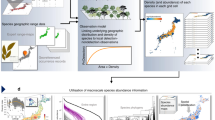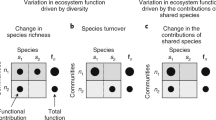Abstract
RANKING of species in a community from most to least important (abundant) to yield an ‘importance-value’ (I–V) curve is a device often used by ecologists to elucidate features of that community. Increasingly in the literature1–5, an I–V curve which obeys the lognormal function is being accepted as describing the ultimate in plant species diversity. South-western Australia is renowned for its apparent floristic richness and high degree of endemism. An ecological study of sand heath, considered by botanists the major repository of this supposed ‘incredible richness’6,7, has revealed a type of I–V curve not previously noted for vegetation. The values for six of seven indices of species diversity examined were as high as, if not higher than, those for the most diverse communities previously recorded, including the richest of tropical rainforests2,4,8–10. All earlier indices of equitability (evenness of species' importance) are based on models of limited applicability and a new index, based on the actual slope of the I–V curve, is proposed here.
This is a preview of subscription content, access via your institution
Access options
Subscribe to this journal
Receive 51 print issues and online access
$199.00 per year
only $3.90 per issue
Buy this article
- Purchase on Springer Link
- Instant access to full article PDF
Prices may be subject to local taxes which are calculated during checkout
Similar content being viewed by others
References
Shimwell, D. W., The Description and Classification of Vegetation (Sidgwick and Jackson, London, 1971).
Bazzaz, F. A., Ecology, 56, 485–488 (1975).
May, R. M., Nature, 258, 285–286 (1975).
Whittaker, R. H., and Niering, W. A., Ecology, 56, 771–790 (1975).
Whittaker, R. H., Taxon, 21, 213–251 (1972).
Whittaker, R. H., Communities and Ecosystems, 2nd edn (Macmillan, New York, 1975).
Gardner, C. A., J. R. Soc. W. Aust., 28, 11–87 (1944).
Marchant, N. G., J. R. Soc. W. Aust., 56, 23–30 (1973).
Foore, M. E. D., J. Ecol., 52, Suppl., 213–226 (1964); ibid., 56, 143–196 (1968).
Knight, D. H., Ecol. Monogr., 45, 259–284 (1975).
Westman, W. E., Aust. J. Bot., 23, 339–354 (1975).
Specht, R. L., Roe, E. M., and Boughton, V. H., Aust. J. Bot., Suppl. 7 (1974).
Raunkiaer, C. The Life Forms of Plants and Statistical Plant Geography (Clarendon Press, Oxford, 1934).
Trepp, W., Schweitz-Landw., 28, 366–371 (1950).
Curtis, J. T., and McIntosh, R. P., Ecology, 31, 434–455 (1950).
Cain, S. A., and de Oliveira Castro, G. M., Manual of Vegetation Analysis, 211 (Harper, New York, 1959).
Kershaw, K. A., Quantitative and Dynamic Plant Ecology, 2nd edn 198–9 (Arnold, London, 1973).
Motomura, I., Jap. J. Zool., 44, 279–283 (1932).
Preston, F. W., Ecology, 29, 254–283 (1948).
Pielou, E. C., An Introduction to Mathematical Ecology, (Wiley-Interscience, New York, 1969).
MacArthur, R. H., Proc. natn. Acad. Sci. U.S.A., 43, 293–295 (1957).
Fisher, R. A., Corbett, A. S., and Williams, C. B., J. anim. Ecol., 12, 42–58 (1943).
Gleason, H. A., Ecology, 3, 158–162 (1922).
Simpson, E. H., Nature, 163, 688 (1949).
Shannon, C. E., and Weaver, W., The Mathematical Theory of Communication (University of Illinois Press, Urbana, 1963).
Sale, P. F., and Dybdahl, R., Ecology, 56, 1343–1355 (1975).
Thatcher, A. C., and Westman, W. E., Proc. ecol. Soc. Aust., 9, 17–33 (1975).
Clark, S. S., Proc. ecol. Soc. Aust., 9, 1–16 (1975).
Speck, N. H., thesis, Univ. Western Australia (1958).
Stebbins, G. L., Flowering Plants—Evolution above the Species Level, (Harvard University Press, Cambridge, 1974).
Author information
Authors and Affiliations
Rights and permissions
About this article
Cite this article
LAMONT, B., DOWNES, S. & Fox, J. Importance–value curves and diversity indices applied to a species-rich heathland in Western Australia. Nature 265, 438–441 (1977). https://doi.org/10.1038/265438a0
Received:
Accepted:
Published:
Issue Date:
DOI: https://doi.org/10.1038/265438a0
This article is cited by
-
Spatial variation and mechanisms of leaf water content in grassland plants at the biome scale: evidence from three comparative transects
Scientific Reports (2021)
-
Elevation induced variation in the breeding traits of a nectar‐feeding non‐flying mammal
Ecological Research (2018)
-
Stand structure and biomass estimation in the Klang Islands Mangrove Forest, Peninsular Malaysia
Environmental Earth Sciences (2018)
-
How belowground interactions contribute to the coexistence of mycorrhizal and non-mycorrhizal species in severely phosphorus-impoverished hyperdiverse ecosystems
Plant and Soil (2018)
-
The critical role of ants in the extensive dispersal of Acacia seeds revealed by genetic parentage assignment
Oecologia (2015)
Comments
By submitting a comment you agree to abide by our Terms and Community Guidelines. If you find something abusive or that does not comply with our terms or guidelines please flag it as inappropriate.



